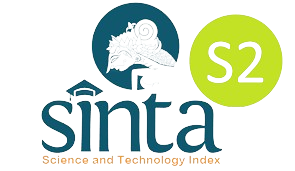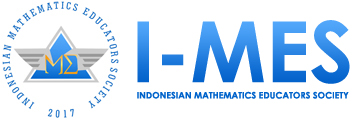Students' misconceptions in algebraic concepts: A four-tier diagnostic test approach
DOI:
https://doi.org/10.29408/jel.v11i1.27604Keywords:
algebraic thinking, diagnostic test, four-tier, misconceptionAbstract
Misconceptions in algebraic thinking refer to misunderstandings in grasping and manipulating abstract concepts such as variables and mathematical relations. These misconceptions are often consistently applied by students in certain situations even though they deviate from the correct concept. This qualitative study used a case study approach focused on analyzing students' misconceptions in understanding algebra, specifically in the topic system of linear equations in two variables (SLETV). This study utilized a four-tier diagnostic test combined with the Certainty of Response Index (CRI) to identify students' misconceptions. The test consisted of 12 questions covering four aspects of algebraic thinking: problem-solving, mathematical modeling, generalization, and analytical thinking. The subjects were 118 junior high school students in Ponorogo who had studied SLETV materials. The results showed that students experienced misconceptions, such as errors in interpreting mathematical statements, simplifying concepts, and organizing ideas. Although their understanding was incorrect, the students exhibited a high level of confidence in their answers. Teachers should use more explicit approaches to convey abstract concepts and provide appropriate feedback. Diagnostic tools such as the CRI can help teachers identify students' misconceptions and offer more effective remedial teaching, thereby significantly enhancing students' understanding of algebra.
References
Abidin, Z., Darwis, M., & Sari, M. (2021). An analysis of student misconceptions in learning algebra using conventional learning model by using three tier test. International Conference on Educational Studies in Mathematics (ICoESM 2021), 238–245. Atlantis Press. https://doi.org/10.2991/assehr.k.211211.040
Aristiawan, A., & Istiyono, E. (2020). Developing instrument of essay test to measure the problem-solving skill in physics. Jurnal Pendidikan Fisika Indonesia, 16(2), 72–82. https://doi.org/10.15294/jpfi.v16i2.24249
Baiduri, Y. M. C., & Ulfah, F. (2022). The intuitive thinking process of high ability students in mathematical problem solving based on gender. Journal of Hunan University Natural Sciences, 49(2). https://doi.org/10.55463/issn.1674-2974.49.2.1
Boaler, J. (2002). Learning from teaching: Exploring the relationship between reform curriculum and equity. Journal for Research in Mathematics Education, 33(4), 239–258. https://doi.org/10.2307/749740
Breiteig, T., & Grevholm, B. (2006). The transition from arithmetic to algebra: To reason, explain, argue, generalize and justify. Conference of the International Group for the Psychology of Mathematics Education, 2, 225–232. PME, Charles University. https://www.diva-portal.org/smash/record.jsf?pid=diva2:1005151
Budayasa, I. K., & Budiarto, M. T. (2019). Students’ intuition characteristics in solve mathematical problem in stage planning. Journal of Physics: Conference Series, 1306(1), 012004. https://doi.org/10.1088/1742-6596/1306/1/012004
Bye, J. K. (2016). Teaching the concept of a variable with meaning and purpose: Connecting contextual mathematical thought to the abstract symbols and operations of Algebra (PhD Thesis, UCLA). UCLA. https://escholarship.org/uc/item/5qr7m28f
Cai, J., & Hwang, S. (2002). Generalized and generative thinking in US and Chinese students’ mathematical problem solving and problem posing. The Journal of Mathematical Behavior, 21(4), 401–421. https://doi.org/10.1016/S0732-3123(02)00142-6
Clarkson, P. C. (2006). Australian vietnamese students learning mathematics: High ability bilinguals and their use of their languages. Educational Studies in Mathematics, 64(2), 191–215. https://doi.org/10.1007/s10649-006-4696-5
El Khoiri, N., & Widiati, U. (2017). Logical fallacies in indonesian efl learners’ argumentative writing: Students’ perspectives. Dinamika Ilmu, 17(1), 71–81. https://doi.org/10.21093/di.v17i1.638
Esti, I., Hersulastuti, H., Indiyah, P. A., & Kun, A. A. (2023). Portrait of education in Indonesia: Learning from PISA results 2015 to present. International Journal of Learning, Teaching and Educational Research, 22(1), 321–340.
Farida, I., & Hakim, D. L. (2021). Kemampuan berpikir aljabar siswa smp pada materi sistem persamaan linear dua variabel (SPLDV) [junior high school students’ algebraic thinking ability on the topic of linear equation systems in two variables (SLTV)]. JPMI (Jurnal Pembelajaran Matematika Inovatif), 4(5), 1123–1136. https://doi.org/10.22460/jpmi.v4i5.p%25p
Fariyani, Q., & Rusilowati, A. (2015). Pengembangan four-tier diagnostic test untuk mengungkap miskonsepsi fisika siswa sma kelas x [Development of a four-tier diagnostic test to reveal physics misconceptions among 10th grade high school students]. Journal of Innovative Science Education, 4(2). https://journal.unnes.ac.id/sju/jise/article/view/9903
Hasan, S., Bagayoko, D., & Kelley, E. L. (1999). Misconceptions and the certainty of response index (CRI). Physics Education, 34(5), 294–299.
Kaput, J. J., Carraher, D. W., & Blanton, M. L. (2017). Algebra in the early grades. Routledge.
Kieran, C. (2004). Algebraic thinking in the early grades: What is it. The Mathematics Educator, 8(1), 139–151.
Latifah, U. L. N., Wakhyudin, H., & Cahyadi, F. (2020). Miskonsepsi penyelesaian soal cerita matematika materi fpb dan kpk sekolah dasar [Misconceptions in solving mathematics word problems on gcf and lcm topics in elementary school]. JRPD (Jurnal Riset Pendidikan Dasar), 3(2), 181–195. https://doi.org/10.26618/jrpd.v3i2.4078
Leinhardt, G., Zaslavsky, O., & Stein, M. K. (1990). Functions, graphs, and graphing: Tasks, learning, and teaching. Review of Educational Research, 60(1), 1–64. https://doi.org/10.3102/00346543060001001
Lucariello, J., Tine, M. T., & Ganley, C. M. (2014). A formative assessment of students’ algebraic variable misconceptions. The Journal of Mathematical Behavior, 33, 30–41. https://doi.org/10.1016/j.jmathb.2013.09.001
Lumbantoruan, J. H., & Male, H. (2020). Analisis miskonsepsi pada soal cerita teori peluang di program studi pendidikan matematika [Analysis of misconceptions in probability theory word problems in the mathematics education study program]. Jurnal EduMatSains, 4(2), 156–173. https://doi.org/10.33541/edumatsains.v4i2.1380
Luneta, K. (2015). Understanding students’ misconceptions: An analysis of final Grade 12 examination questions in geometry. Pythagoras, 36(1), 11 pages. https://doi.org/10.4102/pythagoras.v36i1.261
Mohyuddin, R. G., & Khalil, U. (2016). Misconceptions of students in learning mathematics at primary level. Bulletin of Education and Research, 38(1), 133–162.
Moosapoor, M. (2023). New teachers’ awareness of mathematical misconceptions in elementary students and their solution provision capabilities. Education Research International, 2023, 1–8. https://doi.org/10.1155/2023/4475027
Mullis, I. V., Martin, M. O., Foy, P., Kelly, D. L., & Fishbein, B. (2020). TIMSS 2019 international results in mathematics and science. Boston College, TIMSS & PIRLS International Study Center. https://www.skolporten.se/app/uploads/2020/12/timss-2019-highlights-1.pdf
Mulungye, M. M., O’Connor, M., & Ndethiu, S. (2016). Sources of student errors and misconceptions in algebra and effectiveness of classroom practice remediation in machakos county–kenya. Journal of Education and Practice, 7(10), 31–33.
Parandrengi, M. J., & Hiltrimartin, C. (2023). Students’ errors in solving climate change context mathematical modeling problems. Jurnal Elemen, 9(2), 388–402. https://doi.org/10.29408/jel.v9i2.11422
Pashler, H., Bain, P. M., Bottge, B. A., Graesser, A., Koedinger, K., McDaniel, M., & Metcalfe, J. (2007). Organizing instruction and study to improve student learning. National Center for Education Research. https://eric.ed.gov/?id=ED498555
Paulsen, K. (2006). Applying learning strategies to beginning algebra. The IRIS Center: http://Iris.Peabody.Vanderbilt.Edu/Case_studies/ICS-009.Pdf
Radford, L. (2011). Embodiment, perception and symbols in the development of early algebraic thinking. 35th Conference of the International Group for the Psychology of Mathematics Education Developing Mathematical Thinking, 93. https://www.academia.edu/download/31116195/pme35_ankara_volume4.pdf#page=29
Rittle-Johnson, B., & Schneider, M. (2014). Developing conceptual and procedural knowledge of mathematics. https://academic.oup.com/edited-volume/34494/chapter-abstract/292696975?redirectedFrom=fulltext&itm_content=Oxford_Academic_Books_0&itm_campaign=Oxford_Academic_Books&itm_source=trendmd-widget&itm_medium=sidebar
Rosyidah, A., Maulyda, M., & Oktaviyanti, I. (2020). Miskonsepsi matematika mahasiswa PGSD pada penyelesaian operasi hitung bilangan bulat [Mathematics misconceptions of PGSD students in solving integer arithmetic operations]. Jurnal Ilmiah Kontekstual, 2, 15–21. https://doi.org/10.46772/kontekstual.v2i01.244
Simkin, M. G., & Kuechler, W. L. (2005). Multiple‐choice tests and student understanding: What is the connection? Decision Sciences Journal of Innovative Education, 3(1), 73–98. https://doi.org/10.1111/j.1540-4609.2005.00053.x
Stacey, K. (2011). The PISA view of mathematical literacy in Indonesia. Journal on Mathematics Education, 2(2), 95–126.
Tobey, C. R. (2017). Identifying student misconceptions with formative assessment math probes. McGraw Hill Education.
Yansa, H., Retnawati, H., & Janna, M. (2021). Misconceptions of basic algebra on linear equation in one variable material. Journal of Physics: Conference Series, 1882(1), 012091. IOP Publishing. https://doi.org/10.1088/1742-6596/1882/1/012091
Yasseen, A. R., Yew, W. T., & Meng, C. C. (2020). Misconceptions in school algebra. International Journal of Academic Research in Business and Social Sciences, 10(5), 803–812. https://doi.org/10.6007/IJARBSS/v10-i5/7250
Downloads
Published
How to Cite
Issue
Section
License
Copyright (c) 2025 Hestu Wilujeng, Aristiawan, Joel I. Alvarez

This work is licensed under a Creative Commons Attribution-ShareAlike 4.0 International License.
Authors who publish with the Jurnal Elemen agree to the following terms:
- Authors retain copyright and grant the journal right of first publication with the work simultaneously licensed under Creative Commons Attribution-ShareAlike 4.0 International License (CC BY-SA 4.0).
- Authors are able to enter into separate, additional contractual arrangements for the distribution of the journal's published version of the work (e.g., post it to an institutional repository or publish it in a book), with an acknowledgment of its initial publication in this journal.
- Authors are permitted and encouraged to post their work online (e.g., in institutional repositories or on their website) prior to and during the submission process, as it can lead to productive exchanges, as well as earlier and greater citation of published work.
Jurnal Elemen is licensed under a Creative Commons Attribution-ShareAlike 4.0 International License





